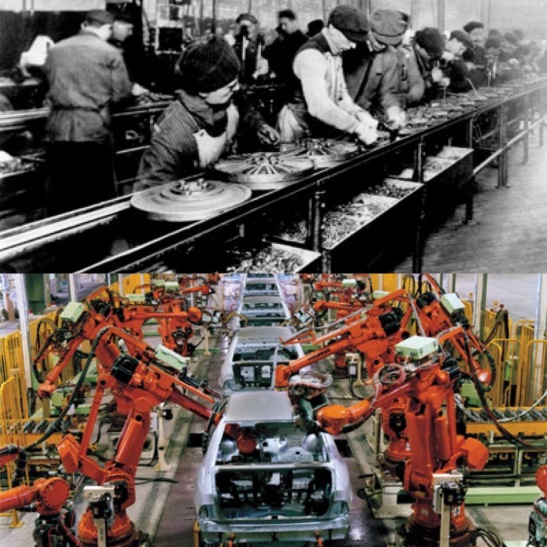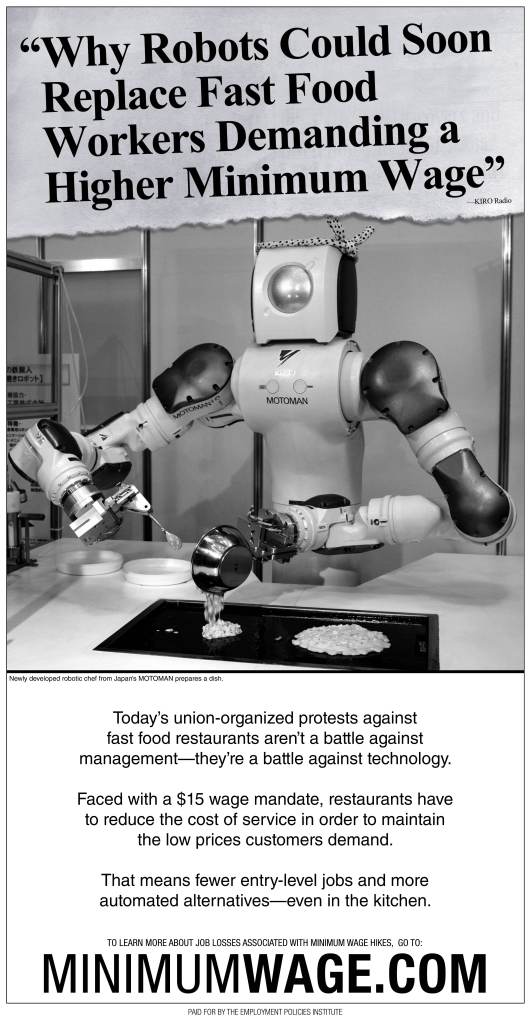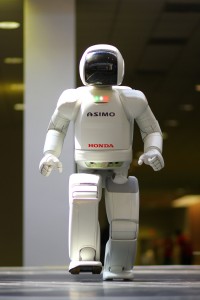The Robots are Coming, Look Busy! – Automation, Work and Class (Communism versus the commanding heights Part 3)
Honda’s Asimo (Photo by Vanillase – wikicommons)
We shall do more things for ourselves than is usual with the rich to-day, only too glad to have small duties and tasks and routines. But beyond this, we shall endeavour to spread the bread thin on the butter-to make what work there is still to be done to be as widely shared as possible. Three-hour shifts or a fifteen-hour week may put off the problem for a great while. For three hours a day is quite enough to satisfy the old Adam in most of us! John Maynard Keynes – Economic Possibilities for our Grandchildren (1930)
Rather than allowing a massive reduction of working hours to free the world’s population to pursue their own projects, pleasures, visions, and ideas, we have seen the ballooning not even so much of the “service” sector as of the administrative sector, up to and including the creation of whole new industries like financial services or telemarketing” David Graeber – On the phenomenon of bullshit jobs (2013)
Every so often at a left wing event, someone gets up and says something really off the wall. In the old days it would be something about North Korea or praising some islamist militia as being a representative of the progressive bourgeoisie. A meeting I attended in Dublin in the 1990’s for the purposes of organizing opposition to the war in Kosovo was notable for an argument between two older men, one arguing that we (a room of about sixty, mostly Irish socialists) should arm the Kosovar Liberation Army (KLA), the other denouncing him as an agent provocateur in league with the CIA. Things have moved on a bit and most of the old ideologues have either died off or called time of their revolutionary careers, so what you get is a mish-mash of conspiracy theory and science fiction. Back in February 2013, at an event dubbed The European Counter Summit, organised by the Socialist Party (Trotskyist, CWI-Ireland), a speaker from the floor told the assembled Dublin left that Asimo, a small humanoid robot being produced by Honda, was coming to take our jobs. Not only was Asimo coming, but we’d all be unemployed within the next six months. There were immediately ripples of laughter around the room as the speaker, now getting ever more flustered, warned us of impending doom. Afterwards, at the obligatory post event session, robot jokes dominated proceedings.
But why was this so funny? Well firstly, even though automation has been a big part of our industrial society since the 1960’s, when many people think of robots, they think Cylons or Terminators or C-3PO and R2D2. Most of us first became aware of robots via science fiction and psychologically we tend to keep them in that department and technology’s progression has accelerated further than our ability to comprehend it. Secondly, the cataclysmic prophesy of full unemployment via full automation seemed off the wall as it did not resonate with peoples’ lived experience. Lastly, Asimo was an awful example to use; anyone who has seen the little android in action will know that it isn’t taking anything off us anytime soon. Automation however, has had a massive impact on all our lives, and has been having, at least since the first industrial revolution. It brought an end to the era of the artisan’s workshop, effectively creating the industrial working class, it increased the availability of affordable motor vehicles and it is a large part of the reason why I work in an office when my ancestors worked in factories, fields and mines. But the robotisation of production that began in the 1950’s has represented a qualitative shift from the scenario where automation helped create new jobs and swelled the ranks of industrial workers, to one where it reduces the need for people to work in factories and on farms and now poses the threat of full automation and mass unemployment. At the same time it represents an incredible opportunity for post-scarcity living, if we get rid of capitalism and hierarchy.
Robots of dawn
Along with its positive aspects, technological advance has a distinctly negative, socially regressive side. If it is true that technological progress enlarges the historical potentiality for freedom, it is also true that the bourgeois control of technology reinforces the established organization of society and everyday life. Technology and the resources of abundance furnish capitalism with the means for assimilating large sections of society to the established system of hierarchy and authority. Murray Bookchin – Post-Scarcity Anarchism
The revolution in industrial robotics began in earnest in 1954 when George Devol filed a patent relating to “the automatic operation of machinery, particularly the handling apparatus, and to automatic control apparatus suited for such machinery.” Two years later, Devol met Joseph Engelberger, a robot enthusiast who was wildly excited by the idea and became his business partner. The result of the endeavor, was Unimate, the world’s first industrial robot. It was a fairly simple automaton, two boxes with a magnetic drum memory connected to a single arm; But it transformed the General Motors construction line and sowed the seeds of the end of the industrial proletariat as we knew it.

Top – a flywheel production line at a Ford motor factory circa 1913
Bottom – a modern automated automobile production line
A decade later, the first electronic computer controlled robot, the Stanford arm was built. The writing was on the wall, factory workers would soon be a small minority within the working class. While the left in general was slow to recognise the way that this was making much of their theory obsolete (in fact most of them still don’t acknowledge it), Murray Bookchin was one of the first to foresee the way that automation accelerated class decomposition, eroded class consciousness and removed any chance of the industrial working class taking over the factories and managing them democratically; In his 1969 pamphlet, Listen, Marxist he wrote, “The proletariat does not control economic life. Despite its indispensable role in the industrial process, the industrial working class is not even a majority of the population, and its strategic economic position is being eroded by cybernation (automation, genetic engineering, nucleonics, and the sophistication of electronic technology in vast numbers of fields and the development of means of surveillance of a highly sophisticated form) and other technological advances.”
Bookchin however was ahead of his time; Industrial automation, in the 1960’s and 70’s was confined to industries where the production line was the norm. Robots of this era were fixed machinery that could not move around autonomously, which is part of the reason they became synonymous with automobile factories and bottling plants. They could however, not work the land or in warehouses or on building sites. These industries still required workers, though due to the advancement in human operated machinery, these other industries saw a decline in number of labourers required, most rapidly in agriculture where the combustion engine was the major breakthrough that allowed one man to do the amount of work that previously took many.
Robot Wars

The image above appeared as a paid for full page advert in the Wall Street Journal in August 2013. The campaign it promotes is run by a right wing think tank to combat the left wing campaign for a $15 minimum wage in the USA. Like a lot of propaganda there’s a grain of truth in there. The field of robotics has made huge advances in the last decade and it is feasible to automate millions of jobs that previously couldn’t have been, due to the need for workers to be mobile and not fixed on a production line. And employers will chose to automate as many jobs as they can as soon as it becomes more cost effective than hiring human labour. They’ve been doing that since the invention of machines, it should come as no surprise.
Amazon has 30,000 robots scooting around it’s warehouses collecting stacks of boxes that have been left there by hydraulic arms. This has been made possible by some problems associated with robot vision and motion being solved. Up until recently mobile robots relied on precision timing, or crude two dimensional vision. Recent breakthroughs have allowed robots to see in three dimensions, using technology similar to Microsoft’s Kinect for Xbox, which shoots infrared beams at objects in it’s path and calculates distance based on the time it takes them to reach their targets. As research in this area bares more fruit, more and more jobs will be automated. But we’re not quite at the point where fast food joints will have robots working in them; Militant tactics to fight low wages and shitty working conditions can still work as was demonstrated by fast food workers in New Zealand, organised under the banner of the UNITE trade union who won a major victory when they forced the abolition of zero hour contracts.
Yet within the next decade, many of those jobs could be replaced by automatons that are effectively very advanced vending machines. While retail jobs have already been severely curtailed by online shopping and automated checkouts (unexpected item in the bagging area), and vending machines have been creeping into schools, airports and hotels, delivery work is now also under threat from drones and soon, driverless vehicles. Artificial Intelligence has already replaced human labour in many areas of finance. All of these advancements are specifically designed to reduce labour costs and have to a greater or lesser extent been creeping in to almost every field of economic activity – probably every field if the articles I keep seeing about Chinese technicians building sex robots are true. So what will happen people who rely on employment to make a living? What becomes of the working classes?
Class of 2016
Masses of labourers, crowded into the factory, are organised like soldiers. As privates of the industrial army they are placed under the command of a perfect hierarchy of officers and sergeants. Not only are they slaves of the bourgeois class, and of the bourgeois State; they are daily and hourly enslaved by the machine, by the overlooker, and, above all, by the individual bourgeois manufacturer himself. The more openly this despotism proclaims gain to be its end and aim, the more petty, the more hateful and the more embittering it is.
Karl Marx and Frederick Engels – The Communist Manifesto (Chapter One)
It was the proletariat’s position at the centre of the process of production that made it directly antagonistic to the capitalist class. It was it’s ability to use this position to expropriate the bosses and run production under it’s own control that made it revolutionary. This was the basis of both the Russian and Spanish revolutions among others. To derive a truly revolutionary theory and program for the present day, we should dispense of any premises that no longer hold true. The automation of production and the continued automation of other sectors of the economy mean that the scenario where the working class takes direct control of production through taking over their own workplaces is a premise that no longer holds true, as Bookchin pointed out in 1969.

This is a problem we need to tackle head on. To do this we have to understand what automation both in AI and Robotics have done to the working class. In major cities around the world today, on a normal weekday, you will notice throngs of white collar workers getting off or onto trains, trams and busses, swiping their travel passes on machines where once there were ticket inspectors. You will see great glass high rise buildings and beyond that glass you will see workers tapping away at keyboards, answering phones and standing around photocopiers. These workers are likely to be putting in long hours for much lower wages than their clean cut appearance suggests and they are likely to be employed in banking and finance or insurance or sales of some sort. On their desks you will see paper coffee cups from one of many local chain cafés and if you look closely enough, you might see the wrapper off a sandwich from the local deli. All these subsidiary industries require workers – students, people between jobs in their chosen fields, people who aren’t qualified for anything else or just can’t find any other work and just need the money. Add in the people who work in food processing and the ones who transport processed foods to the city from warehouses and you have a fair snapshot of the working class in most ‘developed’ countries in the 21st century. This is not the proletariat of the 2oth century.
We do have to qualify this picture by saying that in the so called ‘developing’ world there is still a sizeable industrial working class, the kind that Marx and Kropotkin and all the other theorists of 19th century communism would just about recognise. Faster, cheaper methods of transportation combined with what Naomi Klein calls ‘the shock doctrine’, made it possible to move industrial jobs that were unionised and thus expensive for industry, to Asia and Latin America, where Labour is cheaper. In these countries it may be still possible to talk of workers seizing the means of production, but there are already signs of automation making inroads over cheap labour. This year, Foxconn, the company that makes phones for apple and samsung, replaced 60,000 factory workers – more than half of its workforce- with robots. And soon, as it becomes cheaper, jobs that were moved from the rich countries to poorer countries may be brought back, only with much smaller workforces supplemented by robots. As the manufacturers of unimate pointed out, robots don’t complain, look for a promotion or a payrise. They don’t sleep, they don’t need to eat and they don’t get sick. They are the ultimate way to reduce labour costs and put capitalism’s gravediggers out of business.
Or does it explode?

What happens to a dream deferred?
Does it dry up
Like a raisin in the sun?
Or fester like a sore–
And then run?
Does it stink like rotten meat?
Or crust and sugar over–
like a syrupy sweet?
Maybe it just sags
like a heavy load.
Or does it explode?Langston Hughes – Dream Deferred
If the working class in the west no longer has the power to take over the factories and run them under democratic council control, it still has the power to shut down the global economy. If all the people who work in banking, in insurance, in the civil service and all the service industries withdrew their labour, the accumulation of capital by the ruling class would grind to a halt. But the difference is that these workers do not engage in economic pursuits that are necessary to build a communal economy. These are what David Graeber referred to as ‘bullshit jobs’.
Over the course of the last century, the number of workers employed as domestic servants, in industry, and in the farm sector has collapsed dramatically. At the same time, “professional, managerial, clerical, sales, and service workers” tripled, growing “from one-quarter to three-quarters of total employment.” In other words, productive jobs have, just as predicted, been largely automated away (even if you count industrial workers globally, including the toiling masses in India and China, such workers are still not nearly so large a percentage of the world population as they used to be).
David Graaeber – On the phenomenon of bullshit jobs, Strike! Magazine, 2013
If the global workforce downed tools and occupied its workplaces tomorrow, in most places it would find itself in control of banks, insurance companies, oil giants, hedge funds, investment companies, government offices, coffee shops, sandwich bars, pubs and restaurants and supermarkets. What would be the point of democratically managing the majority of these industries if you intend to do away with capitalism and build a communal, ecological society? You can’t eat an insurance premium and you can’t live in a bank bond. We need new economic practices and new economic structure, built from scratch to accomodate the needs of the global population. We need to abolish the commanding heights of the economy, along with the state and free up the labour of billions so they can construct libertarian communism, while still having the time to improve their quality of life through leisure and intellectual pursuits.
The capitalist system is going through a phase of transition, lurching from prosperity to crisis and back as is it’s nature. However, the current crisis, while not unsolvable for the capitalist class, presents it’s greatest challenge to date. With the productive economy unhooked from the labour process, it finds itself with billions of what were once known as proletarians, without economic activity to engage in. Finance has created a host of ‘bullshit jobs’, but it is unable to completely fill the gaping hole dug by the new robot workforce. Government and private employment agencies try to reduce the affect of this transition by creating militias of labour – constantly retrained, always on standby to be deployed on workfare style programs, or on zero hour contracts.The best educated workforce in history is being shunted from fast food outlets to charity shops to warehouse jobs – this is a ticking time bomb.
Outstanding Contribution to the Historical Process

The good news is, that as it always has done, capitalism has created the technology that makes a communal economy possible. The contradiction at the heart of the capitalist system is not just that it produces more than can be consumed while billions languish in poverty, but that it contains within it the seeds of it’s own negation. It has not completely done away with the digging of it’s own grave, it has just automated the process. It has created the means to do away with wage labour and a working class whose talents and creativity are being squandered. Inevitably those with time on their hands will look around for things to do and will, unconsciously at first, build self managed economic activity into new economic structures, then it will become conscious of itself as a class and organise politically in conflict with the system that it is undermining. Like the system that creates it, this is a class in transition, suspended between two points at once opposites. It continues to be exploited by the capitalist, but between itself it grows communist economic relations, this is the communist proletariat.
Automation can complement and enhance community controlled economic networks, where people put their skills to use for public need instead of being forced to perform tasks they have no interest in or aptitude for. Urban farming, community building repair projects, community kitchens, robotics and IT workshops, music collectives, writers and artists collectives and the like could replace the soul destroying grind of commute, work, eat, sleep, commute. Distribution of goods could be taken over by computer algorithms and self driving vehicles where transport was necessary, leaving the time and space for the human being to reach their full potential, at once an integral part of the wider community and a true individual, with menial tasks that still need to be taken cared of, and what is now gendered work being shared out equally among all those with the ability to do it.
There will still be problems to overcome, like the ecological problems created by waste, procurement of materials for electronics etc that will require international cooperation, energy, which I’ll come back to in a later essay, but we can reduce the impact of this by building stuff that lasts, doing away with the system of built in obsolescence that only makes sense under the irrational profit system. Factories that build consumer products will not need to be constantly in operation, and small scale home made robots would suffice for tasks associated with local industry. If in some senses, for those used to rapid advancement in technology progress at first seems to be slowed down, this will soon be overtaken by the ingenuity of a human race, freed to learn new skills from YouTube videos and community classes, putting these skills to work and creating a society that looks more like Star Trek than Blade Runner. The robots are coming, and our choice is between a society where we have to constantly look busy just to be left alone by the authorities, or one where we choose when to be busy and what to be busy at.
If you want to see more of this sort of thing or my opinions on technology, dogs, anarchism, football and random nonsense, follow me on twitter.
Communism versus The Commanding Heights Contents


Pingback: The New World in Our Hearts – A Critical Engagement With Paul Mason’s PostCapitalism (Communism versus the Commanding Heights Part 2) | Self Certified
Well written 🖒
I have a great interest in doing small projects relevant to artificial intelligence and machine learning.. will you guide me about this topic??